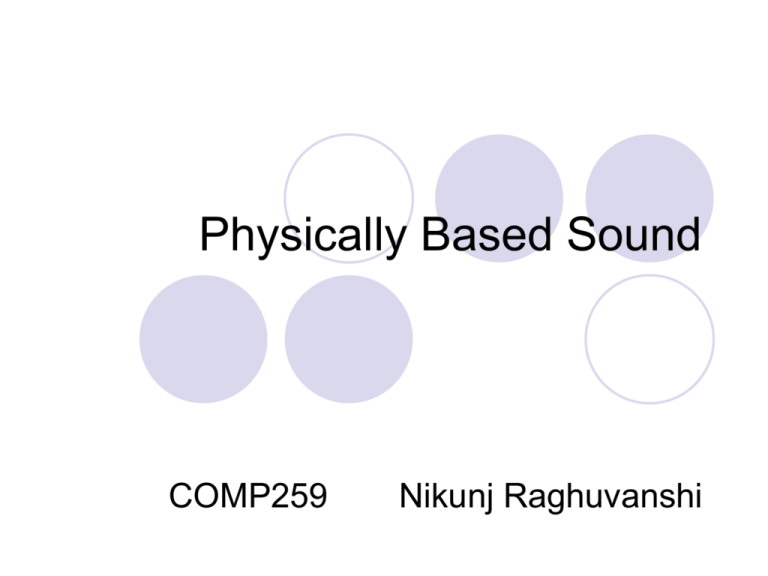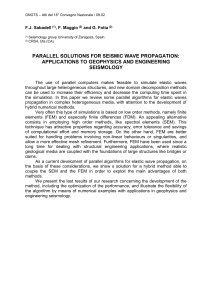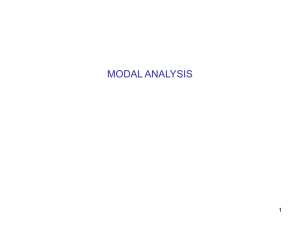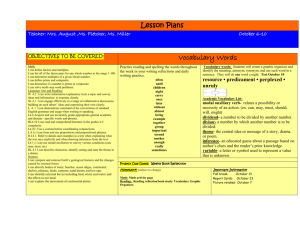Physically Based Sound
advertisement

Physically Based Sound COMP259 Nikunj Raghuvanshi Overview Background FEM Simulation Modal Synthesis (FoleyAutomatic) Comparison/Conclusions Motivation Sounds could in-principle be produced automatically, just like graphics: Sound Rendering Sound Rendering has not received much research effort Main Goal: Automatic generation of non-music, non-dialogue sound Sound Production Today Movies: Foley Artists http://www.marblehead.net/foley/index.html Games: Anyone noticed the huge sound directory in Unreal Tournament? PBS: Sound Production in Nature Collisions/Other interactions lead to surface vibrations Vibrations create pressure waves in air Pressure waves sensed by ear Vibration Surface Vibration Propagation Pressure Wave Perception Ear Main Aims of PBS Physics simulator gives contact/collision information Assign material properties for sound, Wood, concrete, metal etc. Sound simulator generates sound using this data (in real time?) Challenges Sound must be produced at a minimum of ~44,000 Hz Extremely High Temporal Resolution (timesteps in the range of 10-6-10-8 s) Stiffness of underlying systems (eg. Metallic sounds. K/m~=108) Stability may require even smaller timesteps Two Approaches FEM deformable simulation O'Brien, J. F. et. al., “Synthesizing Sounds from Physically Based Motion.” SIGGRAPH 2001. FoleyAutomatic (Modal Synthesis) Kees van den Doel et. Al., “FoleyAutomatic: Physicallybased Sound Effects for Interactive Simulation and Animation.” SIGGRAPH 2001. Main ideas Deformable Simulation (arguably) much more “physically based” Foley Automatic: Additive Synthesis Component Sinusoids Sound Signal Overview Background FEM Simulation Modal Synthesis (FoleyAutomatic) Comparison/Conclusions Simulation Requirements Temporal Resolution Simulate Vibration as well as Propagation Vibration Modeling: Deformable Model for Objects Propagation Modeling: Explicit Surface Representation Physical/Perceptual Realism System Structure Vibration Modelling FEM with Tetrahedral Elements Linear Basis Functions, green’s strain Explicit Time Integration Typically #nodes = 500, #elements = 1500, dt = 10-6-10-7 s Sound Propagation Modelling Fluid Dynamic FEM simulation of surrounding air? Very expensive. Instead… Employ Huygen’s Principle: Pressure Wave may be seen as sum of pressure wavelets Receiver Receiver Pressure Wave Pressure “Wavelets” Surface Vibrations and Sound ˆ Pressure contribution of a patch, p z v n Unit Normal Velocity v n̂ ds Density of Air z c 415 Pa s / m Acoustic Impedance of Air Sound Propagation Speed in Air Surface Vibrations and Sound Approximate differential elements with surface triangles Apply band pass filters: Low pass: windowed sinc filter High pass: DC blocking filter Result: Pressure known for all surface triangles Putting it all together Pressure/Signal at Receiver Filtered Average Pressure Area of Triangle Visibility Term Receiver r ~ pa x r s(t ) cos( ) x r n̂ x̂ Approximation of Beam Pattern Distance Falloff Vibration Propagation Delay Accumulation Buffer Receiver Distance from Source 1 d1 d Delay c Source d2 t2= d2/c Receiver t=0 Sound Propagation Speed t1= d1/c 2 Results: Capabilities General models Generated sounds are accurate Stereo Sound Doppler’s Effect Demo Results: Accuracy Results: Speed Scene TimeStep(s) Nodes/Elems Time/Audio Time Bowl 10-6 387/1081 91.3/4.01 mins 125/265 240.4/1.26 mins 539/1484 1309.7/5.31 mins Clamped Bar 10-7 Vibraphone 10-7 (~1 day) Timings on a 350MHz SGI Origin MIPS R12K processor Overview Background FEM Simulation Modal Synthesis (FoleyAutomatic) Comparison/Conclusions Features Modal resonance model of solids Location dependent sounds Impact, slide, roll excitation models Real-time, low latency Easy integration with simulation/animation Practical Do not model propagation of sound from source to receiver Synthesis Method Emission SoundVibration Samples Force User Propagation Listener Speakers Vibration Surface u(x,t) of body responds to external contact force F(x,t) u(x,t) F(x,t) i 1 2 [ g ( i , x ) 2 2 ]u( x i , t ) F ( x i , t ) x c t Strain Functional Speed of Sound Under suitable boundary conditions, the solution to the PDE is a sum of sinusoids Emission Sound pressure s(t) linear functional L of surface vibration u(x,t) s(t) L u(x,t) s(t ) L[u ( x , t )] i pi ~ z vi nˆ Note that propagation is not modeled in above The Modal Synthesis Model s(t) L u(x,t) F(p,t) “The response u(x,t) of an arbitrary solid object to an external force can be described as a weighted sum of damped sinusoids” Impulse response/modal model Since L is linear, it implies at s(t) must be a sum of damped sinusoids too Example: A 1D string a1 a0 1st Mode Frequency = f0 a0e d 0t 2nd Mode Frequency = f1= 2*f0 sin( 2f 0t ) + a1e d1t ak …Higher modes Frequency = fk= k*f0 sin( 2f1t ) +...+ ak e dkt sin( 2f k t ) Main Idea: Sum contributions of all the modes The point of impact decides the proportions in which the modes are to be mixed: ak. Therefore, ak is a function of p, the point of impact The frequencies and damping parameters are a property of the object, and independent of how the object is hit The Modal Synthesis Model s(t) L u(x,t) F(p,t) N s(t ) ak ( p )e d k t sin( 2f k t ) k 1 Kth mode: Gain Factor Point Damping of impact Term Impulse response, modal model Vibration Frequency Parameters measured experimentally Force Modeling At runtime: Find gain parameters given the location, strength and kind of force. Synthesize sound from previous equation. Impact Sliding Rolling Wavetable Stochastic Impact Forces •Duration: hardness (T) •Magnitude: energy transfer (w) •Multiple micro-collisions Example: F (t ) w (1 cos( 2t / T )), 0 t T Sliding/Scraping Micro-collisions lead to noisy audio-force Sliding/Scraping Wavetable approach Store force parameters Modulate amplitude with energy transfer Modulate rate with contact speed Synthesis Approach Fractal noise represents roughness Filter through reson filter Resonance ~ contact speed Width ~ randomness of surface Rolling No relative surface motion Differences with sliding: •Smoother: Use low pass •More damping •Harder to create •Less understood •Essential coupling? Rolling: Smooth Surfaces Polyhedral objects do not lead to smooth rolling forces Instead use smooth surfaces directly Rolling: Contact Evolution c(u,v) Evolve the contact in Reduced coordinates q = (u,v,s,t,) .. q d(s,t) . q q Rolling: Contact Evolution Piecewise parametric surfaces, loop subdivision surfaces Explicit integration, no stabilization Multiple contacts and conforming contacts are not handled Used only when multiple contacts in close spatio-temporal proximity Demo Dynamic Forces Pebble-in-Wok Demo Contact force Slipping speed Rolling speed Impulses …and locations Results 0.1% CPU time per mode Graceful degradation of quality The bell demo is interactive Uses a PHANToM for interaction Authors do not report any real timings State that “sound quality” is perceptionbased and has no metric as of now Overview Background FEM Simulation Modal Synthesis (FoleyAutomatic) Comparison/Conclusions Discussion FEM: Physically Rigorous and General Too slow for interactive applications Doesn’t scale well Inappropriate to apply a 30fps technique to 44000fps? Maybe too general for the problem domain? Discussion Modal model exploits the vibrational nature Higher Efficiency But, not rigorously physically based Finding the parameters requires experimentation and “earballing” No rigorous correlation between physical and perceptual parameters Discussion For Realtime: Need for a technique to cover the middle ground Extracting modal parameters in general requires solving PDEs Not possible to do in an automated manner Approximate modal parameters and then use modal synthesis? Conclusion PBS involves orders of magnitude smaller temporal and spatial scales Research is sparse, problems are dense Main contributions of the two papers besides vibration modeling: FEM: Efficient modeling of sound propagation FoleyAutomatic: Efficient, Approximate models to handle surface properties and contact forces References O'Brien, J. F., Cook, P. R., Essl G., "Synthesizing Sounds from Physically Based Motion." The proceedings of ACM SIGGRAPH 2001, Los Angeles, California, August 11-17, pp. 529536. Kees van den Doel, Paul G. Kry and Dinesh K. Pai, “FoleyAutomatic: Physically-based Sound Effects for Interactive Simulation and Animation” Computer Graphics (ACM SIGGRAPH 01 Conference Proceedings), pp. 537-544, 2001. Acknowledgements Some images were taken from the referred papers and the corresponding SIGGRAPH slides





